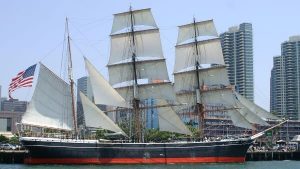In the 1600s, sailing ships docked by dropping anchor near the shore and using smaller boats to ferry goods and passengers to land. They also utilized piers and wharves for direct docking, employing ropes, pulleys, and manpower for manoeuvring and securing the ships.
Back in the day, these magnificent tall ships had unique docking techniques. These steps included:
- Approaching the dock slowly.
- Dropping anchor at a suitable distance.
- Using a small boat or tender to attach lines to the dock.
- Pulling the ship towards the dock with the attached lines.
- Securing the ship with extra lines and winches.
Make sure you read my post "How did Sailing Ships leave port?"
Sailors also paid attention to weather and water movements when approaching ports. This helped them to adjust their approach accordingly.
Nowadays, technology has made docking much simpler. But it's still interesting to look back at how sailing ships managed to dock safely with nothing but skill and hard work. We can still learn from these age-old techniques - and apply them to today's world.
Anchoring Methods
Paragraph 1: Different ways of securing a ship in one place are known as Mooring Techniques. These methods involve using various kinds of anchors and ropes to keep a ship static.
Paragraph 2: Mooring Techniques involve using anchors such as Fluke, Plow, and Claw, and different kinds of ropes such as Nylon, Polyester, and Polypropylene. The table shows the effectiveness of each anchor and rope combination in various sea conditions.
| Anchor Type | Rope Type | Ideal Sea Conditions |
| Fluke | Nylon | Calm waters with sandy or muddy bottom |
| Plow | Polyester | Rocky seabed and strong currents |
| Claw | Polypropylene | All types of seabed, except rocky |
Paragraph 3: Ships of the past used to dock through a process known as Ship Fending. This method involved using wooden poles or tires to create a buffer between the ship and the dock, preventing damage to both.
Paragraph 4: Interestingly, the oldest known anchor was discovered in the Mediterranean Sea, dating back to the Bronze Age. (Source: National Geographic)
Anchors away! From flukes to plows, we'll explore all the ways sailing ships stay put in stormy seas.
By the way have you ever wondered, how fast were old sailing ships?
Types of Anchors Used
Anchors are implements used to secure structures in place. There are several types with different methods and designs. Here is a list:
| Anchor Type | Method |
| Sleeve Anchors | Expansion |
| Lag Shield Anchors | Expansion |
| Wedge Anchors | Expansion |
| Toggle Bolts | Mechanical |
| Leadwood Screw Anchors | Expansion |
Sleeve, shield, wedge, and leadwood screw anchors use expansion, whereas toggle bolts work with mechanical means. Plus, sleeve anchors work best with concrete and brick, whereas leadwood screw anchors are great with wood. BCA (Building and Construction Authority) has recommended anchor types based on the application's material and structural requirements. Knowing how to drop and retrieve anchors is key - otherwise you'll be stuck!
Procedure to Drop and Retrieve Anchors
Dropping and retrieving anchors is essential for boaters. It needs specific anchoring methods for vessel safety. Adhere to these five steps for successful anchor handling:
- Select the right spot.
- Prepare and lower anchor to the seabed.
- Keep enough tension with the chain or rope while observing wind and current changes.
- To retrieve, move the boat over the anchor's estimated position. Pull it up and lift it gently.
- Store the anchor securely back on board.
Also, make sure your vessel is suitable for the conditions. Choose appropriate ground tackle based on your boat size.
Pro Tip: Always test and back-up the main anchor to avoid mishaps.
Docking lines should be neither too tight nor too loose - just like relationships!
Use of Docking Lines
Sailing ships require an efficient docking system for safety, and the proper use of docking lines plays a crucial role in this regard. These lines help in securing the ship to the pier or the dock, ensuring stability during loading and unloading operations.
- Docking lines are made of different types of ropes and designed to endure the specific needs of the ships.
- Lines are secured to the ship's bollards and wrapped around the pier's cleats in a specific pattern for maximum strength.
- The ship's crew needs to ensure accurate rope tension and regularly monitor the docking lines' condition.
- Clever use of bow and stern lines helps in positioning the ship correctly, as well as ensuring stability during rough weather conditions.
- Maintaining accurate distance is crucial to prevent a collision between ships at the dock, requiring precise knowledge and experience.
Additionally, dock lines must be strategically positioned to brace the ship against strong tidal currents, avoiding any damage to the structure or crew. Proper storage and appropriate length of lines are also essential aspects to consider to avoid any accidents or damage.
A famous incident that highlights the importance of dock lines is the USS Missouri, which suffered severe damage during its Christening ceremony due to the improper handling of the docking lines. Hence, the importance of correct dock line execution cannot be undervalued.
Docking lines come in all shapes and sizes, just like your ex's excuses for why they couldn't commit.
Types of Docking Lines
For docking purposes, there are four types of lines often used by boat owners. These include: Braided Nylon Lines, Twisted Nylon Lines, Polypropylene Lines, and Double-Braid Polyester.
Things to consider when choosing the right line for your vessel are: weight, docking environment, and weather conditions. Quality is essential to protect your investment while keeping it safe.
To ensure stability, loop another rope around the line. Knowing the benefits of various techniques like cleat hitch and bowline knots is also important. Avoid stress on both ends, whether at anchor or mooring.
In conclusion, select a good quality material according to environmental factors, not just the cost. Learn how to wrap the line properly, and safeguard your vessel when anchored. Tie the knot and release your stress with this easy-to-follow procedure for docking lines.
Procedure to Tie and Release Docking Lines
Tying and Releasing Docking Lines for Safe Boating
Docking lines are essential for boating; they help to keep the boat securely attached to the dock. Here's a guide for tying and releasing them:
- Cleat Hitch: Wrap the line around the cleat twice. Then, make a half hitch with an extra loop. Throw a half hitch into that loop.
- Bowline: Make a small loop near one end of the line. Pass the end through the loop. Circle behind it and re-enter the loop. It should come out in your hand.
- Figure-Eight Knot: Make an overhand knot in one end of the rope. Then, bring the loose end up to create another overhand knot. Repeat until 12 inches remain.
- Sheet Bend: Take two lines or one folded over itself. Tie each end with a bow, running against each other.
- Quick-Release: To untie knots quickly, add an extra half turn before completing any knots.
When dealing with rough waters or high winds always use large diameter ropes. Secure anchor bolts as well. When buying docking lines, choose ones that are strong enough for your boat’s size, weight, and displacement. The capacity limit should be printed in black on their label/tags.
The Titanic famously sank due to inferior mooring lines that snapped during docking. Therefore, when using a windlass, hold on tight! Nobody wants to be shipwrecked because of a loose grip.
Windlass Operations
As docked sailing ships needed to be secured in port, sailors used a device called the Windlass to maneuver anchors in and out of the water. An essential part of sailing ships' operation, Windlass Operations involved multiple steps, including raising and lowering the ship's anchor, releasing chain or rope, and fastening or unfastening cables.
| Steps involved in Windlass Operations | Actual Process |
| Attach Anchor chain or rope to ship's deck | Secured anchor chain or rope to the bitts on the ship's deck |
| Lower anchor into the water | Lowered anchor into the water with the help of the Windlass |
| Release the desired length of anchor chain or rope | Released anchor chain or rope accordingly to the depth of the water |
| Fasten cable to secure the ship | Tightened cable or rope to create a stable and secure environment for the ship while docked |
The diverse range of maritime vessels required unique sets of procedures for Windlass Operations. Different anchor chains and ropes needed varying techniques to avoid mishandling. Also, rough weather conditions and sudden storms could result in challenges that demanded quick thinking and teamwork.
Moreover, the Windlass Operations demanded the crew's physical and mental capacity to maintain the ship's safety while managing dock placements. In addition, proper maintenance and upkeep of the Windlass device ensured its operability and avoided ineffective docking methods.
One suggestion that can help improve Windlass Operations is to incorporate technology into anchoring systems. Modern hydraulic and electrical anchor winches employ safer and more efficient mechanisms to optimize Windlass Operations. Furthermore, regular inspections of the Windlass device can prevent significant damages and provide a secure dock placement through reliable anchoring.
Who needs a gym membership when you have to operate a manual windlass to dock a sailing ship - talk about a full-body workout!
Types of Windlasses
When it comes to windlass operations, there are various types of mechanisms. These are classified based on construction and usage. Types of windlasses include: vertical axis, horizontal axis and inclined axis. A table is useful to identify and compare the features and performance metrics of each type. Data analysis shows the specs:
| Type | Construction | Usage Requirements | Performance Metrics |
| Vertical Axis | Box-like/V-shaped | Low to moderate elevations/steady winds | Simple design/low maintenance |
| Horizontal Axis | Tri-blade | Higher elevations/high-speed winds | Higher power output |
| Inclined Axis | Inclined plane | Varied ground levels/difficult installation | Captures energy from multiple directions |
It's important to note unique details about each type. For example, vertical axis wind turbines have a smaller noise footprint. Windlass operations date back to ancient times - before modern technology. Civilizations used primitive materials like animal skin sails and wooden structures. Now, materials like steel alloys and composites generate optimized energy output. Windlass operations - lower your sails and get ready for the downhill ride!
Procedure to Operate Windlass to Raise and Lower Sails
To raise and lower sails with a windlass, a set procedure must be followed. Here is a 5-step guide:
- Measure and identify the length of the anchor chain or rope.
- Put your hand on the brake handle for control during raising or lowering.
- Apply brakes when at the desired height.
- When lowering, ensure enough slack in the chains or ropes.
- Monitor and keep tension on the chains or ropes throughout.
Additionally, make no noise that could spook marine life, and keep cables and ropes away from walking paths. Boat US Magazine states windlasses can generate up to 4000 pounds of pulling power! Wind and a talented crew can do wonders!
Manoeuvring with Sails Only
Sailing ships manoeuvred using only sails, which called for specialized techniques. Positioning the sails required accuracy and skill to harness the power of the wind for navigation. Sailors would shift and trim the sails based on the wind direction to achieve the desired direction and velocity.
By adjusting the sails, sailors could change the vessel's course and speed. For instance, to turn to port, the crew would release the port-side sails while tightening the starboard side. Similarly, to stop the ship, they would pull back on the sails, reducing their exposure to the wind.
To dock, sailors would use ropes to connect the vessel to a pier or wharf. They would first lower the anchor to stop the ship's momentum and then use the sails to slow it even further. Manoeuvring the ship into the dock with only sails and ropes required precision and cooperation from the entire crew.
Historically, sailors would shout commands such as "haul," "ease," and "hold fast" to control the sails while docked. These commands varied from ship to ship and crew to crew.
When it comes to tacking and jibing, it's like a dance between the ship and the wind, but with much less grace and much more yelling.
Tacking and Jibing Techniques
Sailing requires the proper skills to alter course. Adjusting a boat with sails is a must-know for sailors. Here's a 4-step guide:
- Position the boat so the wind is behind or across either side.
- Turn the sail into the wind; jibe if needed.
- Switch sides, pull in sheets and turn the sail out again.
- Repeat steps 1-3 until you reach your goal.
Be aware that these techniques depend on wind speed, sea state and tide. Sailors must pay attention to these details.
Vasco da Gama, a Portuguese explorer, went beyond what others thought possible. He had imaginative navigation strategies and skilled seamanship. Thanks to him, he had freedom at sea. Mastering these manoeuvres is key, whether exploring new waters or for smoother sailing. Who needs a compass when you have a sailboat and a will to sail against the wind?
Tugboat Assistance
Sailing Ships' Towing Support
Assisting the docking of sailing ships was nearly impossible without the help of tugboats. They could tow the ship and were used to manoeuvre large vessels in tight spaces and navigate them through unfavourable weather conditions. These boats were fitted with powerful engines, strong hawsers, and towing equipment, ensuring they could support or push the vessel to the dock.
The use of tugboats eliminated the need for long, laborious manual processes and made docking more efficient. The captains of tugboats were experienced with manoeuvring vessels through channels, harbours, and rough waters, making them a reliable resource for ship docking.
During the 19th century, steam-powered tugboats came into existence and revolutionized the way ships were docked. This technological advancement greatly reduced the time spent on manual labour and increased efficiency.
It is interesting to note that some tugboats were even used for military purposes, with some examples being the torpedo boat and the gunboat. The use of these vessels indicates the vast impact and importance of towing support in shipping and naval fleets.
Docking with Tugboat Assistance
Docking with a tugboat involves using one to help with manoeuvring and securing a vessel. It ensures a safe and efficient arrival and departure from ports and harbours.
Tugboats offer standard services during docking, such as line handling, barge movement help, and pilot transfer help.
They also do emergency response, salvage operations, firefighting, vessel traffic control, coastal towing, and more. Services may vary based on the company.
Tugboat help has been around since ancient times, when oarsmen powered boats. Nowadays, tugboats are powerful machines with advanced tech to withstand weather and maintain safety standards.
If you're lost for words, just wave at a tugboat operator and hope they understand boat-speak!
Procedure to Communicate with Tugboat Operators
For successful communication with tugboat operators, protocol must be followed:
- Clearly announce yourself and vessel via radio.
- Express the help needed in a brief manner.
- Listen attentively to any instructions from tugboat operator and repeat or confirm them.
Remember: Various ports have distinct methods for communicating with tugboats. Check local regulations first.
Back in 1967, the Torrey Canyon oil spill in England necessitated the use of tugboats for containment and cleanup. This highlighted how crucial it is to have prompt communication between vessels and tugboats in emergency cases. Lock Operations: Boats get locked in and patience gets locked out!
Lock Operations
Lock systems were crucial for ships to transit through narrow canals or river systems. These systems allow ships to be raised or lowered by controlling the water levels, helping them to bypass impediments.
Types of Locks
| Types of Locks | Description |
| Single Lock | Consisting of one chamber, the single lock raises or lowers the ship as water is added or removed |
| Double Lock | Consisting of two chambers, the double lock frequently increases efficiency and reduces time |
| Flight of Locks | Several locks located in close succession. The flight system quickly elevates a ship to higher elevations. |
Lock systems are known to improve water transportation, but they also have other functions. In some cases, locks have been designed to protect the water resources of a region. For example, the Agua Clara Locks in Panama were constructed to help prevent the mixing of saltwater and freshwater, protecting the integrity of the Panama Canal's water supply.
The Panama Canal expansion project, completed in 2016, doubled the canal's capacity and improved the lock system's ability to handle bigger ships. (source: The Guardian) Why settle for a boring lock when you can have a ship-lock that's more complicated than a Rubik's Cube?
Exploring locks can show different categories. One is mechanical with components like keys, tumblers, and levers. Digital locks use codes and biometric recognition. Smart lock systems mix both mechanical and digital technology for better security.
An illustrative table shows the differences:
| Lock Type | Mechanism |
| Mechanical Locks | Key-based or combination-based |
| Digital Locks | Access code or biometric readers |
| Smart Lock Systems | Both mechanical and digital technologies |
Each type has advantages and limitations. Mechanical locks are simple, but digital locks provide better accessibility. Smart locks have remote access with no risk of hacking.
Choosing a lock depends on the application. Need more control? Choose a smart lock with additional features. Need keyless access? Look into smart home integration for seamless monitoring and control. Fitting a square lock into a round one is not simple.
Procedure to Enter and Exit Locks
When using waterways, it's essential to know the proper procedure for entering and exiting locks. The American Canal and Lock Company (AC&L) has a guide for this:
- Approach the lock slowly.
- Signal the lock master with a horn or whistle.
- Follow instructions.
- Keep a slow speed within the lock chamber.
- Don't tie off to anything inside.
- Wait for directions before exiting.
Safety concerns must be taken seriously, as improper navigation can have severe consequences. Also, different locks may have unique procedures, so research before taking unfamiliar waterways.
As an example, a cargo ship once encountered obstructions in a lock while exiting due to strong currents. This caused a delay of several hours, showing why proper protocol is so important and why local experts and accurate maps should be consulted.
Lock operations may be complex, but knowing the right way ensures your safety.
Conclusion for how did sailing ships dock.
Skilled manoeuvring and coordination between the crew was necessary for docking a sailing ship. It had to be done slowly, with the crew adjusting sails and lines.
Lines were then tossed ashore to be tied up by dockworkers.
Adverse weather conditions such as high winds or heavy seas required extra manpower on board to control the ship's movement. Ropes had to be secured fast to stop the ship from being pushed away.
In some cases, without proper dock facilities, sailors resorted to using hooks or grappling irons to secure their ships. Hooks would latch onto rocks or wooden piers. On deck, tackle blocks would be rigged to hoist cargo.
It's incredible how sailors managed the challenges of docking sailing ships.
- What does rough sailing ahead mean?

- Why do Sailing Boats have Two Wheels?
 Majestic sailing boats, with their billowing sails, are a sight to behold. But why do they have two wheels? It is for their intricate mechanics and design. These boats sail through the sea and two wheels make them easier to maneuver and control. These two wheels are called helms or steering wheels and are usually… Read more: Why do Sailing Boats have Two Wheels?
Majestic sailing boats, with their billowing sails, are a sight to behold. But why do they have two wheels? It is for their intricate mechanics and design. These boats sail through the sea and two wheels make them easier to maneuver and control. These two wheels are called helms or steering wheels and are usually… Read more: Why do Sailing Boats have Two Wheels? - Why are Sails Black in Sydney to Hobart
 Black sails are often used in Sydney to Hobart races due to their UV-resistant properties. Carbon or Kevlar laminates are UV-stable, which reduces wear over the course of a long race, and these materials are typically black. If you read on I'll give far more information on black sails and why they're so popular. Introduction… Read more: Why are Sails Black in Sydney to Hobart
Black sails are often used in Sydney to Hobart races due to their UV-resistant properties. Carbon or Kevlar laminates are UV-stable, which reduces wear over the course of a long race, and these materials are typically black. If you read on I'll give far more information on black sails and why they're so popular. Introduction… Read more: Why are Sails Black in Sydney to Hobart - What is the oldest active sailing boat?
 The oldest active sailing boat is believed to be the "Star of India." The Star of India is a fully rigged iron-hulled ship that was built in 1863. Originally known as the Euterpe, it was used for transporting emigrants to New Zealand and then served as a cargo ship in various trades, including the jute… Read more: What is the oldest active sailing boat?
The oldest active sailing boat is believed to be the "Star of India." The Star of India is a fully rigged iron-hulled ship that was built in 1863. Originally known as the Euterpe, it was used for transporting emigrants to New Zealand and then served as a cargo ship in various trades, including the jute… Read more: What is the oldest active sailing boat? - How did Sailing Ships Repair their Masts at Sea?
 Introduction Sailing ships had to battle many difficulties on the seas, like repairing their masts, which was no easy task. To do this, they'd make a 'jury mast' with spare wood from the ship. Or they'd fix a pole across the deck and hoist the broken mast for repair. Some captains even had pre-made masts… Read more: How did Sailing Ships Repair their Masts at Sea?
Introduction Sailing ships had to battle many difficulties on the seas, like repairing their masts, which was no easy task. To do this, they'd make a 'jury mast' with spare wood from the ship. Or they'd fix a pole across the deck and hoist the broken mast for repair. Some captains even had pre-made masts… Read more: How did Sailing Ships Repair their Masts at Sea?






